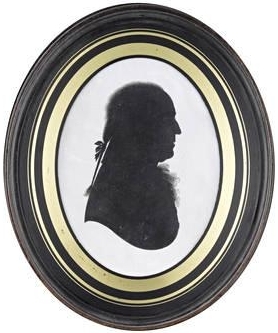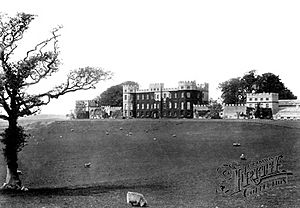Peter Birt facts for kids
Quick facts for kids
Peter Birt
|
|
|---|---|

Silhouette of Peter Birt by John Field (1763)
|
|
| High Sheriff of Glamorgan | |
| In office 1780–1780 |
|
| Preceded by | Christopher Bassett of Lanelay, Pontyclun |
| Succeeded by | Charles Bowen of Merthyr Mawr |
| Personal details | |
| Born | c. 1723 |
| Died | June 1791 |
| Nationality | British |
| Occupation | Businessman |
| Known for | Builder of Wenvoe Castle |
Peter Birt (born around 1723 – died June 1791) was a successful businessman from Airmyn, England. He made a lot of money from a waterway project called the Aire and Calder Navigation. He used some of his wealth to build a grand mansion known as Wenvoe Castle. He also served as the High Sheriff of Glamorgan.
Peter Birt's Business Life
Peter Birt was born around 1723 in Yorkshire, England. Some people said his family was quite wealthy, while others thought he started out as a tailor. He became a merchant, trading goods with countries like Russia.
Birt later got involved in coal mining. In 1758, he and a partner named Sir Henry Ibbetson took over the management of the Aire and Calder Navigation. This was a private waterway in Yorkshire, one of the first of its kind in Britain. It helped boats travel from the North Sea inland to other rivers. Birt and his partner agreed to stop their own trading so no one could accuse them of favoring their own goods on the waterway.
Peter Birt was known for being very efficient, even if he wasn't always popular. In 1771, he asked a famous engineer, John Smeaton, for ideas to make the waterway better. This was to prevent a new canal from being built that would bypass their navigation. Smeaton suggested building new locks (water elevators for boats) and making the water deeper. He also suggested a new canal cut near Haddlesey.
In 1772, Peter Birt became the only person in charge of the Navigation. He signed a 21-year lease and paid a large sum of money for it. This gave him almost complete control over transport on the waterway, and he used this power to his advantage. Soon, Birt owned many boats and several important coal mines in the area.
However, local business owners and merchants were not happy with Birt's control. They complained that the waterway was not well-maintained and demanded changes. Birt eventually agreed to give up his lease. In return, he received a 10% share of the Aire and Calder Navigation Company's property and profits. This was made official by a law passed in May 1774.
The improvements to the Navigation were completed between 1775 and 1779. A new canal, the Selby Canal, opened on April 29, 1778. The Navigation Company became very profitable for the next 50 years, and Birt and his family continued to receive 10% of the income. With his wealth, Birt decided to move away from his home in Airmyn Hall. He wanted to find a new place to retire where he was less well-known.
Building Wenvoe Castle

The owner of the Wenvoe estate, near Cardiff, passed away suddenly in 1767, leaving many debts. The estate was put up for sale in 1769. Peter Birt bought it in September 1774 for a large sum of money. The sale was finalized in May 1775.
Birt had the old castle on the estate completely torn down. However, some of the old materials were used to build the new Wenvoe Castle. The new building was designed by the famous architect Robert Adam in 1776. Birt's friend, Thomas Roberts, was the architect who oversaw the construction. Most of the new castle was built from local "blue stone." However, special Bath stone was brought in from the port of Cardiff, likely for decorative corners and edges. The foundations were almost finished by April 1776, and the roof was on before the end of that year.
The new castle was huge. It had a large main building with lower wings extending from each side. The front of the castle was three stories high and very long, including the two wings. The entire length was topped with battlements, which are the notched walls often seen on old castles. One writer at the time described the house and its grounds as showing "a charming effort of bad taste and bourgeoisity."
Peter Birt served as the High Sheriff of Glamorgan in 1780. He passed away in June 1791 and was buried at Wenvoe. Sadly, his wife (1787), his son Peter (1788), and his daughter Mary (1790) all passed away before him.
Peter Birt's Family Legacy
When Peter Birt died, he had three daughters who were still alive: Ann, Jane, and Judy.
- Ann Birt married Robert Jenner. Their son, Robert Jenner (1776–1824), inherited Wenvoe Castle. The castle then passed to his son, Robert Francis Jenner, and later to his grandson, Robert Francis Lascelles Jenner. Ann Birt's second son, Herbert, later changed his name to Herbert Jenner-Fust. He became an important judge in England. Herbert's son, Dr. Henry Lascelles Jenner, was the first Bishop of Dunedin. The Bishop's son, Henry Jenner, was an expert on the Cornish language.
- Jane Birt married John Price of Llandaff.
- Judy Birt married Sir John Nicholl of Merthyr Mawr in 1787 at Wenvoe. They had one son and three daughters who survived.
The main part of Wenvoe Castle was badly damaged by a fire in 1910. Later, most of the building was torn down, except for one small part. Today, the estate is a golf course.
Sources

